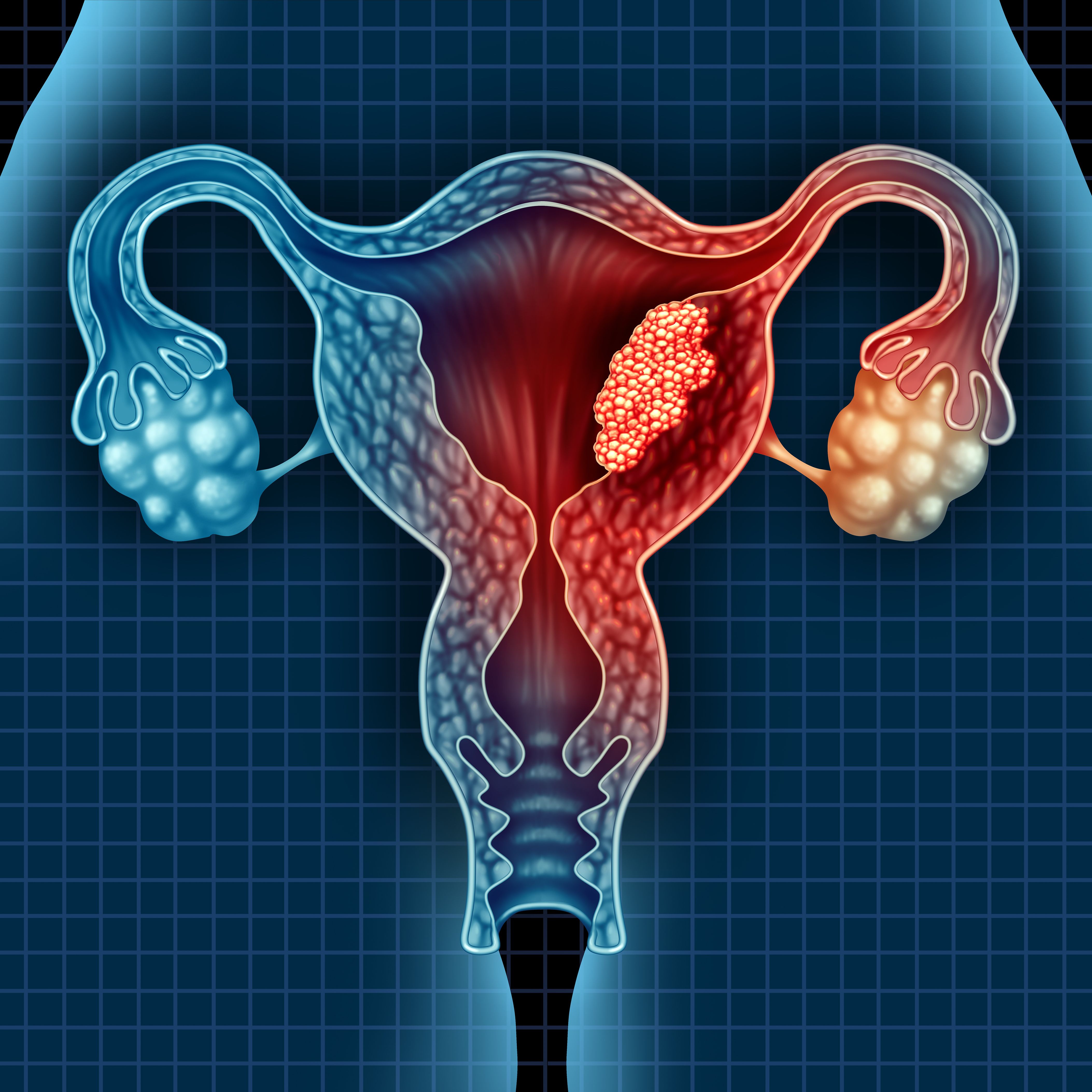Immunotherapy Produces ‘Unprecedented Results’ for Advanced Endometrial Cancer
During a Community Case Forum, Tiffany Bostwick, P.A., discussed how immunotherapy for advanced endometrial cancer has contributed to improved results compared with the previous standard of care.
Uterus Cancer: © freshidea - stock.adobe.com

The transformative impact of two groundbreaking studies focused on immunotherapy to treat advanced endometrial cancer may signal a shift in standard care while sparking enthusiasm within the medical community, an expert said.
“We're in a very fortunate kind of place to be able to see history change in this disease state,” Tiffany Bostwick, P.A., a physician assistant in gynecologic oncology at Atrium Health Levine Cancer Institute in Charlotte, North Carolina, said during a Community Case Forum event, discussing the role of immunotherapy for the treatment of advanced endometrial cancer and recurrent disease.
She emphasized the stagnation in survival rates over 4 decades for endometrial cancer, contrasting sharply with progress in other gynecologic cancers like cervical and ovarian. With over 417,000 global cases and 97,000 deaths annually in the US alone, the urgency for improved therapies is evident, especially considering projections of 122,000 new cases for 2030.
Reflecting on FDA approvals, Bostwick noted a historical reliance on chemotherapy with limited efficacy. However, recent developments offer hope, including the approval of pembrolizumab (Keytruda) for patients with mismatch repair deficiency (dMMR), indicating a paradigm shift in treatment strategies. Accelerated approvals for pembrolizumab plus lenvatinib (Lenvima) and dostarlimab (Jemperli) show how treatment is advancing for recurrent and advanced endometrial cancer, particularly in patients with PD-1 and PD-L1 expressions.
Bostwick's excitement stems from the expanded indications for dostarlimab and pembrolizumab, offering new treatments for patients regardless of MMR status. While FDA guidelines specify patients with DMMR, National Comprehensive Cancer Network guidelines broaden eligibility, reflecting a more inclusive approach to treatment. This inclusivity represents progress in addressing the diverse needs of patients with endometrial cancer.
Case Discussion
In August 2021, a 64-year-old, postmenopausal woman presented with abnormal uterine bleeding, which Bostwick said is, “the most common presenting feature for this disease, is bleeding when you shouldn’t be bleeding.” The patient had menopause at 55 years, which is a little bit late, leading to more estrogen exposure. Her past medical history includes arthritis, obesity (with a BMI of 40), hypertension that is well controlled, and an ECOG score of 1.
The woman undergoes a total laparoscopic hysterectomy, and a bilateral salpingo-oophorectomy with sentinel lymph node mapping. Tissue specimens are also collected for molecular analysis and immunohistochemistry.
The patient receives a diagnosis of stage 1A, grade 1 endometrial cancer. Molecular test results demonstrated that the disease was dMMR, microsatellite instability-high (MSI-H), and estrogen receptor positive.
“Normally I would counsel a patient that this is great news, but we will see that her story turns,” Bostwick said. “So generally, this stage and this endometrial cancer, historically, has a very great prognosis, about a 2% to 3% chance of recurrence.”
In August 2022, the patient reports intermittent pelvic pain for 4 weeks prior, during which she has been seen in surveillance. A CT scan suggests recurrent or metastatic disease with involvement of a single, right external iliac lymph node. “That’s a common place where they can go,” Bostwick said.
The patient is started on what was considered standard of care at that specific time: carboplatin plus paclitaxel for 6 cycles every 3 weeks or every 21 days. She tolerated the chemotherapy despite occasional constipation that was managed with increased hydration and stool softeners. The patient’s disease responded to therapy, as shown in scans at the end of treatment.
Fast-forward to April 2023, disease progression was documented on routine follow-up. The scans showed widespread retroperitoneal, multiple, bilateral pulmonary nodes and a new right internal iliac lymph node. A CT-guided biopsy confirms that it is metastatic endometrial cancer. As a result, the patient was counseled on systemic therapy options, during which she expressed concerns about adverse effects. Shared decision-making resulted in the patient undergoing immune checkpoint inhibitor monotherapy, particularly dostarlimab. This was administered every 3 weeks or every 21 days and, if tolerated, the dose could be increased.
“Usually, [the dose is] doubled,” Bostwick explained. “So pembrolizumab goes from 200 [mg] to 400 [mg], whereas dostarlimab, it’s 500 [mg] to 1000 [mg], and it’s on a Q6-week interval.”
The NRG-GY018 Trial
In the phase 3 NRG-GY018 trial (NCT03914612), researchers aimed to determine whether patients benefit from adding an immune checkpoint inhibitor to chemotherapy or continuing on monotherapy.1 In particular, researchers enrolled 813 patients aged 18 years and older with measurable stage 3/4A, or measurable/non-measurable stage 4B or recurrent endometrial cancer who did not undergo chemotherapy for at least 12 months. Patients were stratified by mismatch repair status (deficient or proficient), ECOG performance score (0, 1, or 2), and receipt of prior chemotherapy (yes or no).
Patients were randomized 1:1 to the experimental treatment arm or the comparator treatment arm. The experimental treatment arm consisted of treatment with pembrolizumab plus carboplatin/paclitaxel every 3 weeks for 6 cycles, followed by pembrolizumab monotherapy for 6 weeks for up to 14 cycles, “which comes out to be…just shy of 2 years,” Bostwick added. The comparator treatment arm, “which is standard of care at the time,” Bostwick mentioned, was placebo plus carboplatin/paclitaxel every 3 weeks for 6 cycles, followed by placebo every 6 weeks for up to 14 cycles.
Primary end points of the trial included progression-free survival (PFS) in patients with dMMR vs mismatch repair proficiency (pMMR). Secondary end points were incidence of adverse events, duration of response, overall survival (OS), and quality of life.
Bostwick commented on the trial’s demographics.
“A lot of our patients are the grade 1, grade 2, grade 3 [histology], which is consistent with what we see in practice,” she said. “It did include serous [adenocarcinoma]. [The] majority of [patients] were chemo naive and had not had radiation therapy, but those were allowed within the study.”
Patients with dMMR in the pembrolizumab plus chemotherapy group experienced a 70% improvement in PFS compared with those in the placebo plus chemotherapy group (HR = 0.30; 95% CI, 0.19-0.48; P < .001). The median PFS in the experimental treatment arm was not reached (95% CI, 30.6-not reached) compared with 7.6 months (95% CI, 6.4-9.9) in the comparator treatment arm.
In patients with pMMR, the pembrolizumab plus chemotherapy group had a 46% improvement in PFS vs the placebo plus chemotherapy group (HR = 0.54; 95% CI, 0.41-0.71; P < .001). The median PFS for patients assigned the experimental treatment was 13.1 months (95% CI, 10.5-18.8) compared with 8.7 months (95% CI, 8.4-10.7) in those assigned the comparator treatment.
“I don’t know about your patients, but that’s a bar mitzvah, that’s a wedding, that’s a birth of a child,” Bostwick said. “These are really important numbers for something that has been downticking in terms of improvement in survival.”
Bostwick added, “So this was hugely exciting for us that we had this significant…landmark study that showed a significant improvement from what was our standard of care.”
Pembrolizumab plus chemotherapy was tolerable, Bostwick explained, and were generally balanced between this group and the comparator treatment group. Many of the adverse events were attributed to chemotherapy, including neuropathy, fatigue, anemia, nausea, constipation, diarrhea, and thrombocytopenia.
For adverse events of special interest, particularly inflammatory responses, patients from both groups experienced infusion reactions, hypothyroidism, hyperthyroidism, colitis, pneumonitis.
“It was interesting because you still see [these] in the placebo [group],” Bostwick said. “But again, these aren’t, to me, exceptionally high. So I would consider this a pretty tolerable side effect for something that is robustly responsive for cancer.”
The RUBY Trial
In the phase 3 RUBY trial (NCT03981796), researchers analyzed data from 470 patients with histologically or cytologically proven advanced or recurrent endometrial carcinoma.2 Patients were randomized 1:1 to receive either 500 mg of dostarlimab plus carboplatin and paclitaxel every 3 weeks for 6 cycles, followed by 1000 mg of dostarlimab every 6 weeks for up to 3 years, or placebo plus carboplatin/paclitaxel every 3 weeks for 6 cycles, followed by placebo every 6 weeks for up to 3 years.
Bostwick noted some differences between the NRG-GY018 trial and the phase 3 RUBY trial. To be eligible for this specific trial, patients had to have stage 3, stage 4, or first primary advanced disease. Of note, researchers also included patients with stage 3C1 disease, which is with no measurable disease.
“These are our patients that we go in, we scan them in advance, we’ve got their biopsy, and we know this is a high-grade histology,” Bostwick explained. “We get scans in advance, get a CT scan, chest, abdomen, pelvis. We see that there’s no evidence of disease. Then we go in and do [more tests], and their sentinels are positive. So they [have] lymph node involvement, but otherwise, no evidence of disease.”
Patients were also allowed in this study if they had carcinosarcoma, clear cell, serous, or mixed histology. “There was a huge population, which corresponds with what we see in real life,” Bostwick added.
The RUBY trial has a similar design to the NRG-GY018 trial, but the stratification was different. For example, patients with dMMR were compared with the overall population. Primary end points included PFS and OS in patients with dMMR compared with the overall population. Secondary end points included PFS, overall response rate, duration of response, quality of life, and safety.
Regarding baseline characteristics, Bostwick noted that most patients had no exposure to radiation there, and most patients were chemotherapy naive.
For PFS in the overall population, patients assigned the dostarlimab regimen experienced a 46% improvement compared with placebo (HR = 0.64; 95% CI, 0.51-0.80; P< .001), with a median PFS of 36.1 months (95% CI, 29.3-42.9) and 18.1 months (95% CI, 13.0-23.9), respectively.
In patients with dMMR and MSI-H disease, the dostarlimab group had a 70% improvement in PFS vs placebo (HR = 0.28; 95% CI, 0.16-0.50; P < .001).
“This is the excitement, this is the astounding kind of unprecedented results that we’ve seen with uterine cancer,” Bostwick said.
Patients with pMMR, microsatellite stable (MSS) disease also experienced an improvement in PFS, although it was not as drastic (HR = 0.76; 95% CI, 0.59-0.98), which Bostwick noted was “somewhat expected.”
She added, “Our dMMR population has more mutations. It’s easy to target.”
Researchers also noted a clinically meaningful OS trend for patients treated with the dostarlimab regimen, especially in those with dMMR and MSI-H (HR = 0.30; 95% CI, 0.127-0.699). In particular, OS at 12 months was 90.1% in the dostarlimab group and 76.6% in the placebo group. At 24 months, this was 83.3% and 58.7% in both groups, respectively.
In the overall population, there was also an improvement in OS with dostarlimab compared with placebo, although it was not as drastic as in patients with dMMR (HR = 0.64; 95% CI, 0.464-0.870; P = .0021). For the dostarlimab and placebo groups, OS at 12 months was 84.6% and 81.3%, respectively, and 71.3% and 56.0% at 24 months.
“This is why we use immunotherapy with those [patients],” Bostwick said. “And the important thing to remember, too, is that this includes serous cancer, this includes carcinosarcoma, this includes clear cell, which are bad actors. … We compare them to ovarian cancer. These are the aggressive ones that cause all sorts of ruckus. And so now we have data to support our treatments and they're included in these trials.”
Researchers learned that the adverse events that occurred in this trial were related to the trial drug compared with carboplatin and paclitaxel. Bostwick added, “It is really kind of our classic [adverse events] that we see with chemo.”
Dosing Recommendations for Dostarlimab
When dostarlimab is used in combination therapy in adults with dMMR/MSH-H primary advanced or recurrent endometrial cancer, it is recommended to administer it at 500 mg every 3 weeks for 6 doses, followed by 1000 mg monotherapy every 6 weeks until disease progression, unacceptable toxicity, or up to 3 years.3 In addition, it is recommended that dostarlimab is administered before carboplatin and paclitaxel when given on the same day.
Dostarlimab as monotherapy can be administered to adults with dMMR recurrent or advanced endometrial cancer and dMMR recurrent or advanced solid tumors. Monotherapy has similar dosing to combination therapy, Bostwick noted, with 500 mg every 3 weeks for 4 doses, followed by 1000 mg monotherapy every 6 weeks until disease progression, unacceptable toxicity, or up to 3 years.
Regarding a mitigation strategy, it is recommended to withhold the dostarlimab dose for adverse reactions of varying severities including pneumonitis (grade 2), colitis (grade 2 or 3), hepatitis with or without tumor involvement of the liver, endocrinopathies (grade 2, 3, or 4), nephritis with renal dysfunction (grade 2 or 3 increased blood creatinine), exfoliative dermatologic conditions, and neurological toxicities (grade 2). Grade 1 or 2 infusion-related reactions can be addressed by interrupting or slowing the rate of infusion.
Bostwick returned to the case discussed during this presentation. Four months after starting dostarlimab monotherapy, repeat scans show that the patient had a partial response to treatment. She experienced some fatigue, weakness, and a 10-pound weight gain, for which she underwent a workup, “all of which looks fantastic,” Bostwick said. The patient was diagnosed with hypothyroidism, for which she receives levothyroxine while continuing dostarlimab treatment.
Immune-Related Adverse Events
Bostwick noted that it is important for patients to be aware of possible adverse events and to contact a provider immediately if they experience any symptoms. Before starting treatment, patients should also understand that adverse events from immunotherapy can affect the whole body, may appear at any time even after finishing treatment, and most adverse events are treatable with steroids or other medications. There are some rare but serious adverse events that may lead to death if untreated, Bostwick added.
She noted the importance of using consultation services for rare, challenging adverse events.
“The [National Comprehensive Cancer Network] guideline does provide some guidance on that. But for giant cell arteritis, I wouldn’t recommend doing a temporal artery biopsy in your clinic. These things are incredibly rare and specialized, so there’s certainly a role for our consult teams. But some of the more common ones, we can recognize and kind of manage our colitis or pneumonitis.”
Bostwick also explained the timing of immune-related adverse effects. The first thing she typically sees is rash, occurring a little before the 4-week mark of initiating treatment. This is followed by colitis, which can happen in the 2 to 3 months after starting treatment. Liver enzymes can start increasing after 6 to 12 months.
“Usually the first month [after starting treatment], they're feeling pretty good, but maybe a little rash or something that doesn't really itch them,” Bostwick said. “You can use a little hydrocortisone cream, as necessary. But usually that's kind of the honeymoon period and then more to come.”
References
- Eskander RN, Sill MW, Beffa L, et al. Pembrolizumab plus Chemotherapy in Advanced Endometrial Cancer. N Engl J Med. 2023;388(23):2159-2170. doi:10.1056/NEJMoa2302312
- Mirza MR, Chase DM, Slomovitz BM, et al. Dostarlimab for Primary Advanced or Recurrent Endometrial Cancer. N Engl J Med. 2023;388(23):2145-2158. doi:10.1056/NEJMoa2216334
- Jemperli. Prescribing information. GlaxoSmithKline, LLC; 2021. https://www.accessdata.fda.gov/drugsatfda_docs/label/2021/761174s000lbl.pdf



